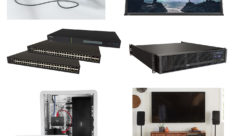
AV Brings The Action Inside
The exclusive Club Room inside the Agannis Arena on the Boston University campus features high-end AV that caters to important guests.
Getting controlBroadcast audioVersatile videoWowing guestsHD VIDEO TRANSMISSION
CHALLENGE: Integrate independent AV and control systems from different integrators into a seamless system.
SOLUTION: Install high-quality components and perform extensive control programming to blend the systems together.
THE ELITE Club Room inside the new Agannis Arena on the University of Boston campus is just one part of a multimillion-dollar construction project, but it’s an important one. As a place where influential donors, suite holders, and distinguished guests congregate before, after, and during hockey games and other events, the room — and its approximately $130,000 AV system — was a top priority.
The AV system needed to be able to recreate an arena-type experience for games, while also being able to accommodate more subdued presentations, dinners, and banquets during the rest of the year. To accomplish this, the project’s AV consultant, Dallas-based Pelton Marsh Kinsella (PMK), specified large projection screens and full-range loudspeakers to broadcast hockey games taking place just outside the Club Room, along with plasma displays and high-intelligibility loudspeakers to supplement a variety of other events.
To help integrate and consult on the room’s AV system, PMK project manager Gary McAuliffe and his team worked alongside Columbia, MD-based AV systems integrator SPL Integrated Solutions, Wilmington, MA-based AV solutions company Univisions Crimson Group, and Sudbury, MA-based audio and acoustical consulting firm Cavanaugh Tocci. Each company was responsible for different parts of the separate audio, video, and control systems in the room.
The common denominator in the project was Crestron control systems. The companies decided on a Crestron MP2E integrated control system with Ethernet to efficiently bring the systems together. “The Crestron systems in the room are able to talk to each other,” says Pat McConnell, projector manager for SPL. “The audio and video racks are able to communicate and hand-off signals to each other.”
Mike McCosh, senior systems programmer at Univisions Crimson Group, handled the majority of the Crestron programming. Along with the Crestron MP2E, McCosh installed a Crestron CT-1000 wall-mounted control panel for in-room control, as well as Crestron QM-RMCRX room media controller/QuickMedia receivers at each of the projection device sites.
“Each one of the QuickMedia devices uses Cat5 cable for transmission of AV signals and includes an integrated Crestron 2-Series Ethernet control processor,” McCosh says. “The QM-RMCRX devices are able to manage the displays. They receive the video signals from the main unit in the control rack and handle any switching and power control issues to make sure the signal gets where it needs to go.”
One minor problem that McCosh ran into involved switching between video sources when transmitting composite or S-video signals. “Composite video is typically carried on one wire, and S-video requires two wires,” he says. “We had to write our own code to tell the units to keep all of the channels open at the same time, rather than switching between them.”
This was necessary because high-definition signals require the use of all three channels at the same time for transmission (see sidebar).
While the Crestron programming was a major piece of the project, before any programming could be done, audio and video signals from the arena’s in-house production facility located beneath the arena had to be routed to the Club Room. PMK used CobraNet connectivity from the arena’s production room to send the audio signals from its PA system and on-air broadcasters into the Club Room, which gave the room multiple audio options.
The CobraNet audio signals are input to a Peavey MediaMatrix X-Frame 88 digital signal processor located in a Middle Atlantic MRK-4431 equipment rack inside the Club Room’s control room. From there, the audio sources can either be sent to four EAW JF80z program loudspeakers —one on each side of the two projection screens —or to the 42 Atlas Sound FA138T167 coaxial ceiling loudspeakers that surround the room.
Knowing that the two discrete loudspeaker systems would serve entirely different purposes, Matt Moore, project manager at Cavanaugh Tocci, decided to use two QSC CX 302V power amplifiers to feed the Atlas Sound ceiling loudspeakers, along with two QSC CX 502 power amplifiers for the EAW loudspeakers
The room also includes Shure UHF U24/58 wireless microphones and Countryman Isomax IV lectern microphones for programs and guest speakers. The microphone signals are input to a Shure SCM-810 automatic mixer located in the equipment rack.
Audio from a Denon DN-780R cassette deck, Denon DCM-280P CD player, and Denon TU-1500RDP AM/FM tuner provides additional audio options for the room.
While the EAW loudspeakers gave the room loud, arena-like sound, PMK knew it needed something in addition to flat-panel displays to really bring the live action of a hockey game into the upscale Club Room. The resulting video solution includes two 72-inch-tall by 128-inch-wide Stewart Filmscreen Luxus Deluxe projection screens, which are mounted on the long front wall of the rectangular-shaped room. Although front-wall placement would have been ideal for maximum visibility, the architectural detail of the room included expensive wood paneling, so the integration team had to avoid drilling mount holes for any type of projection screen lift.
“The original intent was to be able to remove or have the projection screens hidden when they weren’t being used,” Wolloff says. “But because the front wall was made of one-of-a-kind paneling, we didn’t want to drill holes that would be there forever. So, we worked with one of the mill workers to create stand-offs that fit in between the grooves of the wood paneling. This allowed us to bolt the screen to the wood panels, and still be able to remove them without harming the paneling.”
Another challenge arose when Wolloff began installing the two Sanyo PLVWF10 projectors with Sanyo LNS-S02Z projector lenses for the front projection system. As with the projection screens, Boston University wanted all of the AV components to remain as inconspicuous as possible. Because the room had high, open ceilings, the projectors had to remain visible, but the Crestron QM-RMCRX devices at each projector only compacted the problem. To hide the AV components, Wolloff designed a custom enclosure to conceal both the Crestron device and the projector.
Wolloff enlisted the help of one of the site’s skilled laborers to help fabricate the solution. Wolloff worked with a steel worker to build a triangular box that could be mounted to the ceiling and painted to look like part of the room’s décor.
In addition to projection capabilities, the room includes two 50-inch Panasonic TH-50PHD6UY and two 42-inch Panasonic TH-42PHD6UY plasma displays. During hockey games, the displays are primarily used as secondary displays to the projection screens, or to display TV programming. During other events, the plasma displays are also used to show video from Marantz PD-930 DVD players, Marantz MZ8300P VHS decks, or multimedia content from laptop plug-ins around the room.
For More Information
- Atlas Sound www.atlassound.com
- Countryman www.countryman.com
- Crestron www.crestron.com
- Denon www.usa.denon.com
- EAW www.eaw.com
- Marantz www.d-mpro.com
- Middle Atlantic www.middleatlantic.com
- Panasonic www.panasonic.com
- Peavey www.peavey.com
- QSC www.qscaudio.com
- Sanyo www.sanyo.com
- Shure www.shure.com
- Stewart www.stewartfilmscreen.com
Amy Brown, general manager of Agannis Arena, says that the AV system in the Club Room has drawn rave reviews from almost everyone who has used it, which isn’t always a given in sports facilities. “In today’s modern arena setting, you need to have full multimedia and AV capabilities to really enhance the guest experience,” Brown says. “This system provides that wow factor.”
Brown says it has more than fulfilled the original goal of creating a fully functional environment. “Whether it’s a bar-mitzvah where they want to show video of that young person’s life, a speech where they tie into our sound system, or a multimedia PowerPoint presentation, the room gives us full flexibility for any type of event you can think of,” she says.
The video signals inside the Club Room at the Agannis Arena on the University of Boston campus are sent to the room’s plasma displays and projectors as composite or S-video signals. At each display device, a Crestron QM-RMCRX room media controller/QuickMedia receiver accepts incoming video signals and can either open one channel for composite video or two channels for S-video, but not all three. While this setup works well for standard-definition transmission, it created a problem for high-resolution signals, which require all three channels for transmission.
Mike McCosh, senior systems programmer at Wilmington, MA-based AV solutions company Univisions Crimson Group, the Club Room’s video systems integrator, served as the project’s Crestron programmer, and was tasked with devising an appropriate solution. “Because of the newness of component video, the Crestron QuickMedia devices weren’t set up to simultaneously open all three channels,” he says. “But, by design, the devices were capable of delivering computer signals, which have about the same bandwidth across the wires as component video. So there was no reason technologically that they couldn’t pass component video as well.”
McCosh says that once he realized it could be done, it took time to write custom programming to keep all three channels open at once. However, he notes that such programming wouldn’t be an issue today.
“Since that project, Crestron has updated their firmware, so it can be done now without any custom programming,” he says.
Paul Kramer is associate editor of Pro AV magazine. He can be reached at pkramer@ascendmedia.com.









